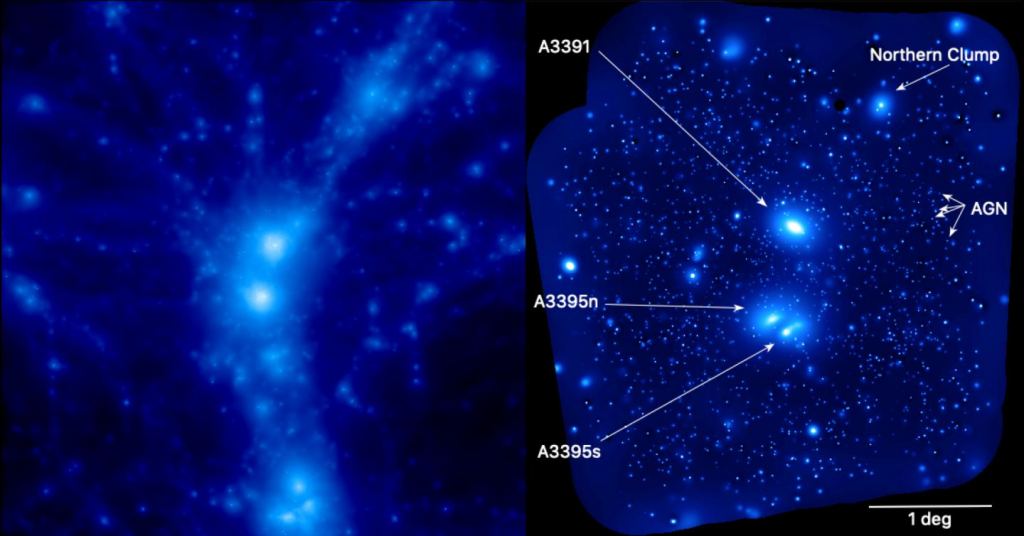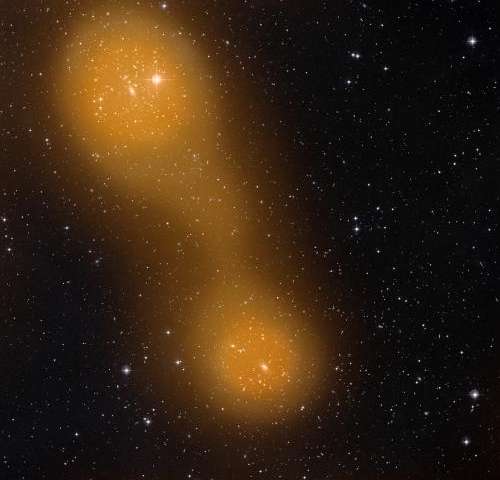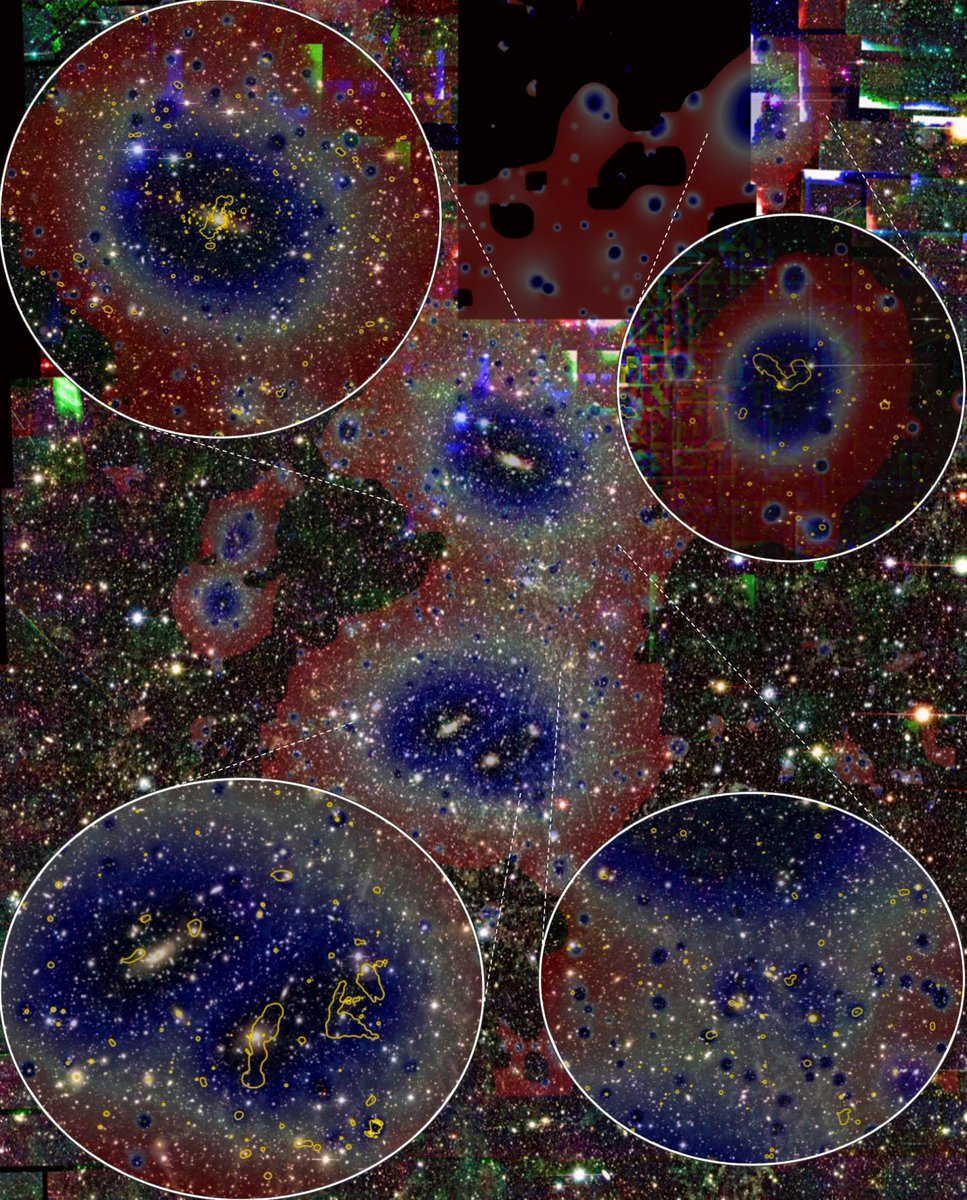Minute vibrating strings found in string theory are not the only ones that are of interest to physicists. The Standard Model of particle physics provides for a theory regarding a different type of string – this one is a string of very sparse gas strung over very long distances. In fact, the standard model predicts that a large percentage of “baryonic matter” (i.e. the type that makes up everything we can see and interact with) would be contained in these filaments. And now for the first time, scientists led by a team at the University of Bonn in Germany have detected one of these super long strings of gas.
The part of the Standard Model that predicts these strings starts with the hyper-inflationary period immediately following the Big Bang. According to the Standard Model, the only reason that there is literally anything in the universe at all is because the sphere that was the early post-Big Bang expansionary universe was slightly denser in some places than it was in others.

Credit: Reiprich et Al, Astronomy & Astrophysics
Those concentrations of matter gravitationally pulled other matter closer, eventually creating the first galaxies, stars, planets and everything else in the known universe. The Standard Model also predicted that those gravitational forces would also cause a tail of trailing particles that would show up as a kind of pathway between where the matter was originally located and where it was pulled.
However, so far it has been immensely difficult to detect these filaments because they are exceptionally sparse. Best estimates put the concentration of gaseous particles at 10 particles per cubic meter. That is a much lower concentration than what even our best vacuum machinery can artificially create.

Credit: ESA
Such a diluted stream of gas does not allow for many traditional methods of direct detection. However, the team searching for these filaments had access to a new instrument – eROSITA, an X-ray telescope run by the Max Planck Institute for Extraterrestrial Physics. For the first time ever eROSITA was able to pick up the x-rays emitted from these incredibly sparse gas clouds.
That gas cloud was observed while collecting data on the Abell 3391/95 set of three galaxy clusters. Not only did it pick up data from the gas clouds, but it showed the galaxies that comprise Abell and how the filament actually connects each galaxy to others in the cluster.
Credit: Reiprich / Astrophysics Research Center Youtube Channel
What’s even more impressive, the research team doesn’t think they have observed the full extent of the filament itself, even though the part they did detect was already more than 50 million light-years long. The sheer size of these filaments would help to explain why up to 50% of all interactable matter is theoretically still hidden in them.
eROSITA’s data does lend more credence to the idea that the filaments are indeed where that missing matter is hiding. But until more data is collected and these filaments are observed in more than one place, that new x-ray telescope, and the scientists who observe with it, will have many more strings to find.
Learn More:
Astronomy & Astrophysics – Original Paper
University of Bonn – Longest intergalactic gas filament discovered
Space.com – This intergalactic filament is 50 million light-years long, the longest we’ve ever seen
ScienceAlert – Astronomers Spot Elusive 50 Million-Light-Year Long Thread Tied to Cosmic Web
Lead Image Credit: Optical iamge of the Abell galaxy cluster where the x-ray work was done. Credit: Reiprich et all, Astronomy & Astrophysics


In the last few years there have been a series of similar discoveries of the earlier missing 50 % of the 6 % – or 3 % – of the universe energy content which is baryonic matter. Recent examples includes using the newfound fast radio bursts:
“Roughly half of the “normal” matter in the universe—the stuff that makes up stars, planets, and even us—exists as mere wisps of material floating in intergalactic space, according to cosmologists. But astronomers had no good way to confirm that, until now. A new study has used fast radio bursts (FRBs)—powerful millisecondslong pulses of radio waves coming from distant galaxies—to weigh intergalactic matter, and the results match up with predictions.”
[ https://www.universetoday.com/149404/a-single-filament-of-gas-has-been-discovered-that-stretches-50-million-light-years/ ]
But seeing the wispy gas from emissions gives more detail. Having said that the article rubs me the wrong way regarding cosmology. I don’t think that the standard model of particles has any way to predict how much of the universe will be matter, that is a task for the cosmic background spectra that tells us the various amounts by type [ “Secrets of the Cosmic Microwave Background” @ PBS Space Time. https://www.youtube.com/watch?v=C4CKtEQJGMY&ab_channel=PBSSpaceTime ].
More precisely it is a part of the inflationary variants of the Lambda-Cold Dark Matter cosmologies that makes up modern cosmology. And they now describe the order of events differently, as inflationary hot big bang cosmology.
“Among most people who study the early Universe, inflation is accepted as the new consensus theory. We might not know everything there is to know about inflation, but either it — or something so similar to it that we don’t have an observation to tell them apart — must have happened.
With all that said, what does that mean for our cosmic origins? From a timeline perspective, what comes first: the Big Bang or inflation?
Believe it or not, the above graph contains all the information you’d need to know for certain. Two of the curves — red and blue — represent a Universe dominated by either matter or radiation. As you can clearly see, if you extrapolate them back arbitrarily to the past, you get an inifinitely [sic] small size at a finite time of t=0, which is a singularity.
But if at some early time, the Universe isn’t dominated by matter or radiation, but by a form of energy inherent to space itself, you get the yellow curve. Note how this yellow curve, since it’s an exponential curve, never reaches zero in size, but only approaches it, even if you go infinitely far back in time. An inflating Universe doesn’t begin in a singularity like a matter-dominated or radiation-dominated Universe does. All we can state with certainty is that the state we call the hot Big Bang only came about after the end of inflation. It says nothing about inflation’s origins.”
“There are a lot of people who mean “the initial singularity” when they say “the Big Bang,” and to those people, I say it’s long past due for you to get with the times. The hot Big Bang cannot be extrapolated back to a singularity, but only to the end of an inflationary state that preceded it. We cannot state with any confidence, because there are no signatures of it even in principle, what preceded the very end-stages of inflation. Was there a singularity? Maybe, but even if so, it doesn’t have anything to do with the Big Bang.
Inflation came first, and its end heralded the arrival of the Big Bang. There are still those who disagree, but they’re now nearly a full 40 years out of date.”
[ https://www.forbes.com/sites/startswithabang/2019/10/22/what-came-first-inflation-or-the-big-bang/?sh=147a17b54153 ]
That first link should have been https://www.sciencemag.org/news/2020/05/mysterious-radio-bursts-reveal-missing-matter-cosmos .